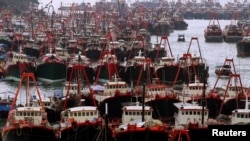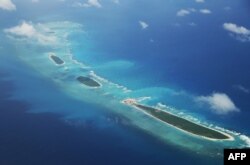Vietnam is protesting China’s annual spring-into-summer fishing ban that Hanoi says partially “violates” its sovereignty.
In a statement issued prior to China’s implementation of what it calls a “fishing moratorium,” Vietnamese Foreign Ministry spokesperson Le Thi Thu Hang said on April 29 that Hanoi has consistently and clearly expressed its objection to the ban that this year runs from May 1 to August 15.
The ban, first imposed in 1999, applies to all waters north of 12 degrees latitude. This includes most of the Gulf of Tonkin and the Paracel Islands in the South China Sea, which are occupied by China but also claimed by Vietnam.
Hang said that “part of the scope of the fishing ban violates Vietnam's sovereignty over the Paracel Islands and Vietnam's sovereign rights and jurisdiction that are determined under the United Nations Convention on the Law of the Sea [UNCLOS] [adopted] in 1982, the Agreement on the delimitation of the Gulf of Tonkin between Vietnam and China signed in 2000.”
“Vietnam asks China to respect Vietnam's sovereignty over the Paracel Islands, sovereign rights and jurisdiction over its seas when taking measures to conserve biological resources in the East Sea [South China Sea], without complicating the situation, [and] to contribute to maintaining peace, stability and order in the East Sea region,” she added.
According to the state-run China Daily, the ban is “part of the country's efforts to promote sustainable marine fishery development and improve marine ecology.”
In a response to a similar protest made by the Philippines over the ban this year, Chinese Foreign Ministry spokesperson Zhao Lijian said during the regular daily press briefing on June 1, “The summer fishing moratorium in the South China Sea adopted by China is a normal measure of conserving marine biological resources in waters under China’s jurisdiction, and a manifestation of fulfilling obligations under international law including UNCLOS by the Chinese side.” Zhao was referring to the United Nations Convention on the Law of the Sea.
He continued to say, “China cannot accept the unwarranted accusation of the Philippine Foreign Ministry. We hope the Philippine side can view the measures objectively and correctly, and earnestly fulfill the obligations as a littoral state of the South China Sea to jointly promote sustainable development of fishery in the South China Sea.”
Vietnam and the Philippines are among seven claimants for territorial sovereignty in the South China Sea. The other nations are Brunei, Indonesia, Malaysia and Taiwan. The United States is a nonclaimant in the South China Sea and has called on China to abide by international law.
Gregory Poling is director of the Asia Maritime Transparency Initiative at the Washington-based Center for Strategic and International Studies, or CSIS. He told VOA in 2020 that damage to sea life in the South China Sea is clearly worsening.
Fishing in the sea quickly expanded in the 1980s and early 1990s, when it reached about 10 million tons per year. Those numbers come from a 2017 study. The lead researchers of the study — Cui Liang of China’s Xiamen University and Daniel Pauly from the University of British Columbia — said fishing activities leveled off after that expansion.
In recent years, boats have been fishing in deeper waters and catching smaller fish. Five years ago, fishing in the South China Sea accounted for 12% of the worldwide fish catch, CSIS estimates show.
Echoing the official lines of Vietnam’s government, Phan Huy Hoang, chairman of Quang Ngai Provincial Fisheries Association, said on June 1 that China’s ban, is “illegal” and “has no impact” on Vietnamese fishermen.
He told VOA Vietnamese that he is urging fishermen to ignore China’s ban, which he said is “unreasonably imposed,” and to venture out to the sea to fish as usual, which is similar to a position recently taken by the Philippines.
Asked if Vietnam should consider litigating against China over the ban, Hoang said diplomatic protest should continue as legal means have no effect on Beijing.
“Litigation against China does not help. The Philippines sued China and the international court ruled that the nine-dash line has no value, no legal basis, and history, which China still ignores. Suing has no effect,” Hoang said, referring to the 2016 verdict by the Hague-based Permanent Court of Arbitration in favor of Manila over Beijing. The nine-dash line is used by the Chinese Communist Party (CCP) to illustrate claims to the South China Sea. It encompasses approximately 90% of the more than 3 million-square-kilometer South China Sea.
In an effort to boost fishermen’s morale and assert Vietnam’s sovereignty over disputed areas, Vietnam’s fisheries surveillance force on April 20 launched a campaign called “A million national flags for fishermen to maintain their presence at sea.”
Nguyen Quang Hung, who heads the surveillance force, told VOA Vietnamese that fishermen were happy to receive the flags as those gifts empower them. Asked if Vietnam’s call for fishermen to defy China’s ban would put them at risk, Hung declined to comment further.








